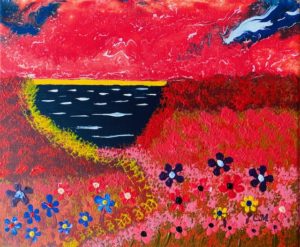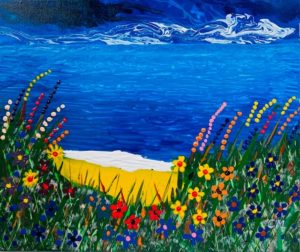Composition has often been covered within realistic art but rarely mentioned in abstract realism art. This is partly due to the seemingly lack of any need for composition within abstract paintings. However, if we split composition into several parts we can discuss the importance of the need for the viewer to come to some kind of understanding as to what they are being asked to see within the painting.
Shapes
The size and position of shapes is important. Within Clements McCulloch’s abstract paintings often there are 5 to 7 shapes – some small and others large. The need for balance as required in realistic landscape paintings is not essential as the placement of these shapes can be anywhere within the image. However, some abstract realism artists still try to balance their painting with the use of large shapes versus several small shapes. It is more pleasing to the viewer’s eye.

The shapes should be interesting – so unusual design in nature. Not regular squares or rectangles. Viewers want to see something unusual to draw their eye towards it. Interlocking shapes are a good example – the way the shapes meet each other. Especially, large shapes surrounded by several small ones. Sometimes they blend together using their colours and at other times a hard line is used to draw the viewers attention.
Colour
The use of colour within abstract realism can be a subject of discussion. For example, we are used to accepting that a tree has a brown trunk and green leaves. Many abstract realism artists will paint blue trunk and purple leaves – just to make a different viewpoint. However, many artists in this field will use colour to convey messages. Allegory, as it is known within the painting circle – a story with a hidden symbolic meaning. A message of hope and happiness; trust or loyalty. This is due to certain colours being associated with feelings and emotions.
Abstract realism often uses recognisable shapes but with unusual colours to highlight the painting in a particular way. Clements McCulloch often has an abstract sky with realism within the rest of the painting.
The colours are used for messaging. Always an uplifting message is being conveyed to give the viewer a positive feeling when seeing the image. To inspire them when they need it.
Lines
There are three recognisable lines within paintings that are well composed. Straight lines – often representing the horizon in conventual paintings but used as marks in abstract art. C shaped lines often drawn to convey a message of security or comfort. In realistic paintings this maybe a bay or pond in the scene. Finally, there is the S shape. Often a path or road in a scene but as in abstract it is another way to make the viewer follow with their eyes to the centre of attention in the painting.
Too often abstract paintings lack a centre of attention and the viewer is left confused as to what to look at. Sometimes, it is enough to draw their eye with a particular colour beside a contrasting one. However, the best way Clements McCulloch has found is to use lines that the viewer can follow to the centre of interest. As in the painting below.

Value
The different values (light and dark areas within a painting) are important. Artist are always asked to stop and assess whether their colours are offering a range of different values. To make a painting interesting, the difference within the overall painting should have light areas and dark areas. This is achieved by the use of paint. For example, although the goal might be to paint a happy, sunny and bright painting; there should be an area even just a small area of dark colour just to offer contrast and a different value within the overall image.
Texture
The use of texture especially in abstract realism is widespread. The reason is that it adds interest to the painting. It helps draw the viewer’s eye to that area. It can be a simple squiggly line or a more complex design raised up from the surface of the canvas. More often than not the purpose of the use of texture is to convey a message to the viewer. The texture adds to the paintings theme which has already been set by the choice of colours. As in Clements McCulloch’s painting shown below, where the white waves hit the beach.

Centre of Interest
Every painting should have a centre of interest. Otherwise, where does the viewer look! Of course they will say it’s a nice painting, probably because they like the colours etc. but without a centre of interest they will be left puzzled as to the reason the artist painted the image. The composition of the image painted by the artist should be designed to lead the viewer’s eye to a particular spot or area of the painting. Some of the techniques mentioned above are used to do just that.
Clements McCulloch uses these techniques as well as contrasting colours beside each other to draw the viewer to where he wants them to look. He uses the Rule of Thirds as well as the Golden Ratio in almost all of his paintings because that has been proven over the centuries to be the best composition technique.
Sometimes, the artist will want to have more than one centre of interest. Two or even three areas may been designed to catch your eye more than other areas of the painting. In realistic paintings the artist may have areas that are blurry in detail – these are parts of the overall image that are essential for the painting, but are not where they want you to look.
Centre of interest areas will always be in focus and show detail. Within abstract realism it is similar. The artist will attract your eye by making the use of sharp edges and contrasting colours. Whereas, other areas will have blended colours that merge into each other perhaps seamlessly.